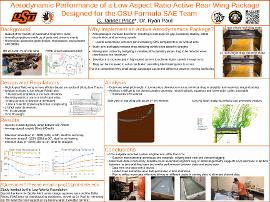| dc.contributor.advisor | Paul, Ryan | |
| dc.contributor.author | Price, C. Tanner | |
| dc.contributor.other | Spoiler Alert! Senior Design Capstone Team | |
| dc.contributor.other | Society of Automotive Engineers (SAE). Formula SAE Bullet Racing Team | |
| dc.date.accessioned | 2022-05-05T14:08:07Z | |
| dc.date.available | 2022-05-05T14:08:07Z | |
| dc.date.issued | 2022-04-15 | |
| dc.identifier | oksd_Wentz_2022_price | |
| dc.identifier.citation | Price, C. T., & Paul, R. (2022, April 15). Aerodynamic performance of a low aspect ratio active rear wing package designed for the OSU Formula SAE team. Poster session presented at the Oklahoma State University Wentz Research Scholars Symposium, Stillwater, OK. | |
| dc.identifier.uri | https://hdl.handle.net/11244/335525 | |
| dc.description.abstract | Computational and empirical studies were performed to analyze and present the effects and advantages of an active front wing aero package for the Oklahoma State University (OSU) Formula SAE team, known as Bullet Racing. The study was made up of a series of 2D Computational Fluid Dynamics (CFD) analyses of a three-tier front wing system capped with large endplates. The second and third-tier wing feature an adjustable deflection angle to enable an accelerometer-controlled computer to vary the amount of down-force based on the local curvature of the track with embedded servo motors. Of interest were the angles which created maximum downforce for high-speed cornering, minimum drag for straightaways where top speed is of the upmost importance, and maximum drag for increasing stopping power, allowing for later braking. Furthermore, the split geometry between the left and right halves of the wing allowed for an anti-roll moment to be created, increasing cornering capability. CFD was performed at various in-flow speeds and wing pitch angles to study how lift and drag change in different driving conditions. | |
| dc.description.abstract | After building and testing the wing kit, it was found that adding it to the vehicle in a static mode increased performance by 15% in lateral acceleration and decreased skid pad lap time by +1.5 seconds. Performance between active and static wing modes were similar, with the better performing mode being up to driver preference. Due to limited availability to test, the active code developed would benefit from more tuning, which might lead to better performance as compared to a static wing. | |
| dc.description.sponsorship | Lew Wentz Foundation | |
| dc.format | application/pdf | |
| dc.language | en_US | |
| dc.publisher | Oklahoma State University | |
| dc.rights | In the Oklahoma State University Library's institutional repository this paper is made available through the open access principles and the terms of agreement/consent between the author(s) and the publisher. The permission policy on the use, reproduction or distribution of the article falls under fair use for educational, scholarship, and research purposes. Contact Digital Resources and Discovery Services at lib-dls@okstate.edu or 405-744-9161 for further information. | |
| dc.title | Aerodynamic performance of a low aspect ratio active rear wing package designed for the OSU Formula SAE team | |
| osu.filename | oksd_Wentz_2022_price.pdf | |
| dc.description.department | Mechanical and Aerospace Engineering | |
| dc.type.genre | Poster | |
| dc.type.material | Text | |
| dc.type.material | Image | |
| dc.subject.keywords | FSAE | |
| dc.subject.keywords | aerodynamics | |
| dc.subject.keywords | Formula SAE | |
| dc.subject.keywords | active aero | |
| dc.subject.keywords | racecar | |
